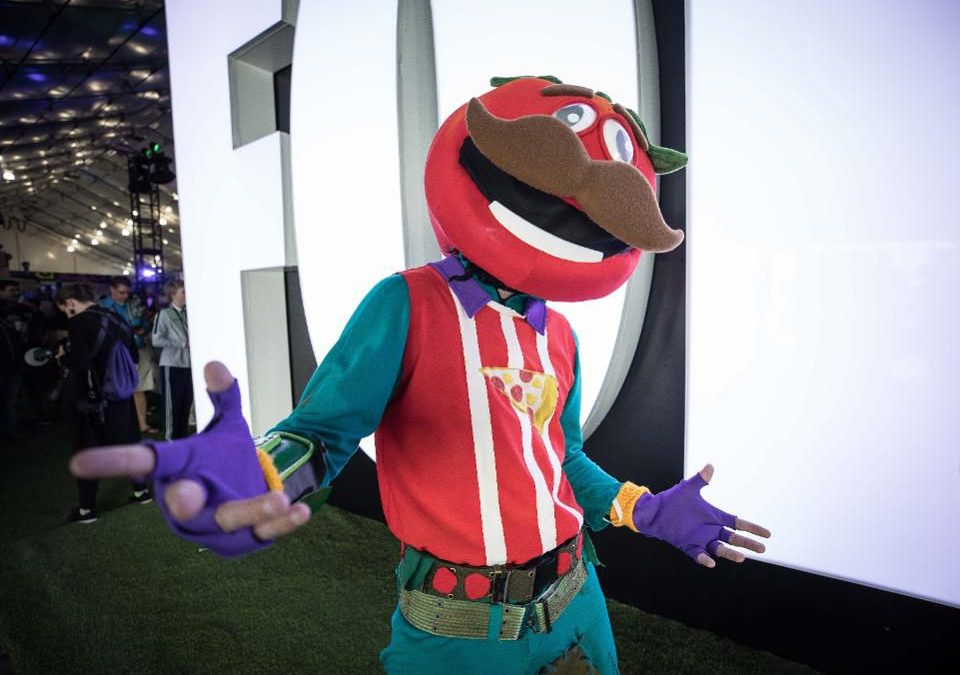
by Stone Marshall | Dec 14, 2018 | Awesome Book News, Free, Intro, Minecraft News, Minecraft questions, news, parent-news, State of Stone, Stone Marshall Book News, Stone Marshall Books, Stone Marshall Club, Stone Marshall Minecraft Adventures, Uncategorized |
Today, Apple unveiled the list of the most popular apps and games (free and paid) for iPhone and iPad in 2018 and you’ll find below the top 10 charts for each category.
This year, Battle Royale-style games like Fortnite and PUBG Mobile dominated global gaming culture with exciting, last-player-standing action, while innovative apps like Fabulous, Shine, 10% Happier and Headspace expanded the practice of wellness around the world to make self-care more accessible than ever before, said Apple.
Atherton Research’s Take
In the free app category, Google’s YouTube was the most downloaded app on both iPhone and iPad, while Messenger, the Facebook app, Gmail, Netflix also appeared in the top 10 for both iOS devices.
On the iPhone, the most popular apps are predominantly for communication (Instagram, Snapchat, Messenger, Facebook, Bitmoji and Gmail), whereas apps on the iPad tend to be more video-oriented (YouTube, Netflix, Amazon Prime Video, YouTube Kids).
On the iPhone paid apps side, selfie-editor FaceTune ($3.99) and drawing iPad app Procreate ($9.99)—which was also awarded best iPhone app of the year by Apple “editors”— took the top spots.
In the free games category, Fortnite is the absolute winner on both iPhone and iPad. Hole.io, Rise Up, Helix Jump, Love Balls, and Rules of Survival were also popular on both iOS platforms.
Froggipedia is an augmented-reality educational app which explores the life cycle and intricate anatomical details of a frog and won Apple’s 2018 iPad App of the Year award.DESIGNMATE
In paid games, Heads Up! ($2.99) won the crown on iPhone—it was also the #5 most popular paid games on iPad—while Microsoft’s Minecraft ($6.99) was the most popular on the iPad and the second most downloaded app on the iPhone. Geometry Dash, Bloons TD 6, and The Game of Life were also popular paid games on both iOS platforms.
On a side note, Apple also named its own favorites apps, selected by “editors” working at the tech giant.
On the iPhone, Apple selected drawing app Procreate Pocket and Donut County (a story-based physics puzzle game where you play as an ever-growing hole in the ground) as its app and game of the year, respectively.
On the iPad, the Silicon Valley company chose Froggipedia (an augmented-reality educational app which explores the life cycle and intricate anatomical details of a frog) and puzzle-game Gorogoa as this year’s app and game, respectively.
Top 10 Free iPhone Apps:
YouTube
Instagram
Snapchat
Messenger
Facebook
Bitmoji
Netflix
Google Maps
Gmail
Spotify Music
Top 10 Paid iPhone Apps:
Facetune ($3.99)
Kirakira+ ($0.99)
Dark Sky Weather ($3.99)
HotSchedules ($2.99)
PlantSnap ($2.99)
AutoSleep Tracker for Watch ($2.99)
Sky Guide ($2.99)
1 Second Everyday: Video Diary ($4.99)
The Wonder Weeks ($2.99)
Afterlight 2 ($2.99)
Top 10 Free iPhone Games:
Fortnite
Helix Jump
Rise Up
PUBG Mobile
Hole.io
Love Balls
Snake VS Block
Rules of Survival
Roblox
Dune!
Top 10 Paid iPhone Games:
Heads Up! ($2.99)
Minecraft ($6.99)
Plague Inc. ($0.99)
Bloons TD 6 ($4.99)
Pocket Build ($1.99)
Bloons TD 5 ($2.99)
Geometry Dash ($1.99)
The Game of Life ($2.99)
Papa’s Freezeria To Go ($0.99)
Grand Theft Auto: San Andreas ($6.99)
Top 10 Free iPad Apps:
YouTube
Netflix
Messenger
Facebook
Amazon Prime Video
Google Chrome
Gmail
YouTube Kids
The Calculator
Amazon Shopping
Top 10 Paid iPad Apps:
Procreate ($9.99)
Notability ($9.99)
GoodNotes 4 ($7.99)
Toca Life: Pets ($3.99)
Duet Display ($9.99)
Toca Life: After School ($3.99)
XtraMath ($4.99)
Toca Hair Salon 3 ($3.99)
MyScript Nebo ($7.99)
Toca Kitchen 2 ($3.99)
Top 10 Free iPad Games:
Fortnite
Roblox
Kick the Buddy
Love Balls
Helix Jump
Color by Number Coloring Game!
Bowmasters – Multiplayer Game
Hole.io
Rise Up
Rules of Survival
Top 10 Paid iPad Games:
Minecraft ($6.99)
Geometry Dash ($1.99)
The Game of Life ($2.99)
The Room: Old Sins ($4.99)
Heads Up! ($0.99)
Bloons TD 6 ($4.99)
Goat Simulator ($4.99)
Five Nights at Freddy’s ($2.99)
Lego Jurassic World ($4.99)
Terraria ($4.99)
Jean Baptiste “JB” Su is Vice-President and Principal Analyst at Atherton Research, a global technology consulting and intelligence firm advising clients plan, build and deliver successful go-to-market strategies. You can follow him on LinkedIn (https://goo.gl/z5zGlx) or Twi… MORE
Author: Jean Baptiste is a Vice-President and Principal Analyst at Atherton Research, a global technology intelligence firm advising clients deliver successful go-to-market strategies.
Read more online: https://www.forbes.com/sites/jeanbaptiste/2018/12/04/apple-unveils-2018s-most-popular-apps-youtube-fortnite-minecraft-and-more/#d59c1460dcd8
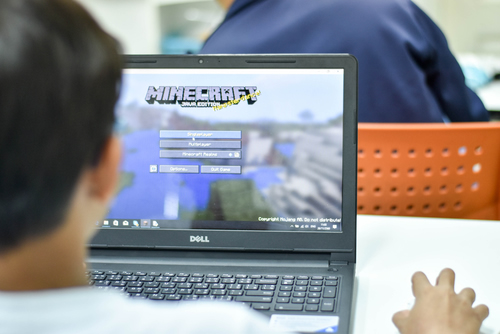
by Stone Marshall | Dec 13, 2018 | Awesome Book News, Free, Intro, Minecraft News, Minecraft questions, news, parent-news, State of Stone, Stone Marshall Book News, Stone Marshall Books, Stone Marshall Club, Stone Marshall Minecraft Adventures, Uncategorized |
Minecraft has pretty amazing potential as a teaching tool. In general, it promotes creativity and problem-solving as it boosts engagement. But it also can improve achievement when confident teachers incorporate it into instruction.
It’s easy for students to become absorbed in Minecraft worlds, mainly due to the game’s “sandbox” nature–it’s open-ended and offers unlimited possibilities for math, science, and building challenges.
And the game isn’t just for STEM classes, either. It can help build social and emotional skills, it can illustrate concepts found in literature and history classes, and more.
If you need inspiration, or just a little help getting started, you might find it in one of the following examples.
1. Minecraft has a fascinating link with social and emotional learning (SEL). A report based on interviews, a global survey, and case studies shows that 98 percent of teachers say problem solving is the top SEL skill their students learn from Minecraft. Students also develop creativity (86 percent), critical thinking (93 percent), and collaboration (91 percent). Half of teachers say they think it also helps students build empathy.
2. Gaming, including Minecraft, can be a powerful motivator to students, leading them to greater engagement and achievement. Students frequently walk away from homework when it is too difficult, but difficult games are another matter–kids walk away from games when they’re too easy. Difficult games present a positive challenge for students. A challenging task “stretches” a student’s brain, and the more a person expects his or her brain to do different things, the more pathways that person’s brain will develop.
3. We don’t necessarily think of Minecraft as a literary place, but that’s where many people are wrong. Students can use it to build worlds or landmarks from novels they read in class. Other teachers have students create journals in Minecraft and leave the journals in their class-created Minecraft world so other students can find the journals and react to different prompts or ideas.
4. Students can recreate historical buildings or places as part of a history project, and they also can download them and drop them into a world. With a little bit of creativity, classes can relive historical experiences–they can re-walk the Oregon Trail or land a ship in a new place and figure out how to govern a society. Minecraft characters can die temporarily and need food to survive, making the game a good way to navigate some of these challenges.
5. Minecraft’s math applications are endless. For instance, students can complete a Minecraft-inspired math project that is related to volume, area, and perimeter. Or, they can work on a multi-project STEM challenge and rotate around the classroom. If students don’t have access to the game in their classrooms, teachers can create paper-based challenges (check out the resources on Teachers Pay Teachers).
6. Computer science and coding skills are in high demand in today’s workforce, but qualified workers are hard to come by. Students can use their love of Minecraft to learn how to code and build strong programming skills.
7. Minecraft can bring the “A” to STEAM, too. Check out Tate Worlds: Minecraft Reimagined, which takes famous works of art and recreates them in the block-based world. Students can tap into their creative side while also planning and organizing an art project.
These are only a few examples of the many, many ways Minecraft can change teaching and learning. Check out Minecraft’s Education page for even more resources.
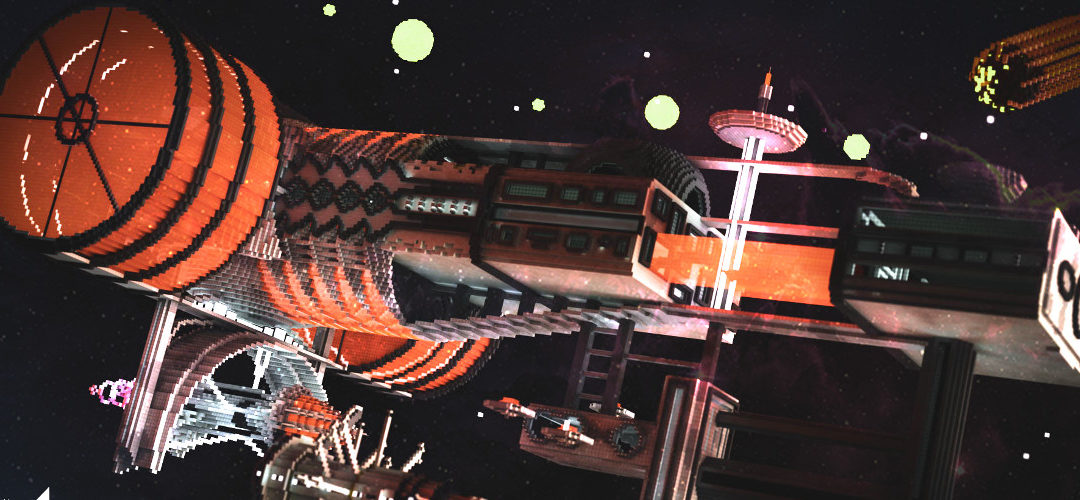
by Stone Marshall | Dec 13, 2018 | Awesome Book News, Free, Intro, Minecraft News, Minecraft questions, news, parent-news, State of Stone, Stone Marshall Book News, Stone Marshall Books, Stone Marshall Club, Stone Marshall Minecraft Adventures, Uncategorized |
Actually, 256 blocks is the limit. Anyway, look at this build!
Something tells me I wouldn’t do well in outer space. Travelling makes me nauseous, I never did learn to do the moonwalk, and how am I supposed to resist taking off my spacesuit helmet so I can play with my wonderful hair?
So if you ever do go to space, it’s probably for the best if you leave me on Earth. But while fettered to the same old planet, I can at least stargaze in awe at excellent builds like Futuristic Space Station!
This piece of interstellar ingenuity is the work of Polish builder, Milosz. “I love working on creative things,” Milosz tells me. “I’m always full of amazing ideas that I try to make into reality whenever I can!”
A catering student and aspiring DJ, Milosz was drawn to Minecraft as yet another outlet for his creativity. “I love the freedom of creation [in Minecraft]. I can use a big variety of building materials, which allows me to create whatever I imagine.”
“Also, its blocky appearance creates such a lovely, unique atmosphere.” Well said! We should put that on the back of the box!
Molosz claims that the “sky is the only limit” in Minecraft, but is it really?
Because this space station build seems to ignore all limitations, in both scope and detail. It looks futuristic and sci-fi, but also pleasingly plausible. If someone told me this build was based on an actual design for a real space station, I’d believe them! And not just because I’m an earthbound ignoramus who, as previously established, shouldn’t be let anywhere near a spacecraft.
The space station uses understated colours, making it something of a monochromatic marvel (which is what I would have called this article, if a better Minecraft.net writer hadn’t already used that).
Milosz achieved this stylish look by sticking to a consistent set of “black, grey and white blocks,” he tells me “such as quartz, polished andesite, bedrock, black glass, polished diorite, iron blocks and cyan terracotta.”
Keeping the ship to a strict set of blocks makes other uses of colour stand out more, like the red stripes across the satellite, or the cheeky comet that appears to be heading straight for the space station. Er, this thing does have force field shields, right?
But Milosz didn’t just choose these blocks for their dark palette. He also considered how they would look as part of such a massive construction: “The majority of blocks used to create my build have simple textures,” he explains “which makes everything look good in large scale.” Keep that in mind if you want to try a large-scale build of your own!
“I’ve also added some colour and light using sea lanterns,” Milosz points out, a smart use of some of the more recent blocks we’ve added to the game with the Update Aquatic. Maybe Milosz should fill this space station with Pillagers after our next update? Hmmm, actually, that’s probably astro-not a good idea.
Milosz says that the hardest part of the build was “connecting all the different elements” so they made sense as one coherent structure. At least he can rest assured that the toughest element of the build was also one of the most successful: I love how this feels like a logical construction, the kind of functioning facility you could imagine astronauts/pillagers-who-are-seriously-out-of-their-depth navigating through the cosmos.
So given that he knows how to design a great facility for such an endeavour, how does Milosz feel about going to outer space himself? Is it something he’d like to do someday? (Mojang’s lawyers have asked me to make it clear that we’re not offering to pay for this trip – spoilsports).
“Of course I would love to go to space,” says Milosz, unsurprisingly. “Although, only for a brief period of time. Something like a one-week space journey would be great!”
If any of the millions (billions?) of astronauts who check Minecraft.net every day are reading this, get on that!
Render made by Boxu
Read more online: https://minecraft.net/en-us/article/sky-no-limit
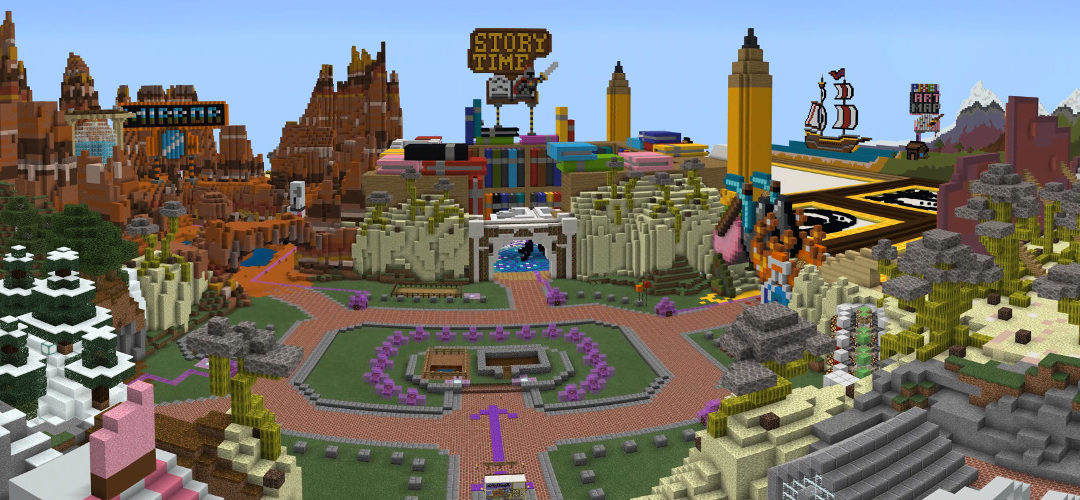
by Stone Marshall | Dec 12, 2018 | Awesome Book News, Free, Intro, Minecraft News, Minecraft questions, news, parent-news, State of Stone, Stone Marshall Book News, Stone Marshall Books, Stone Marshall Club, Stone Marshall Minecraft Adventures, Uncategorized |
Get inspired by this new world, available free starting today!
Did you watch Minecon this year? It was our epic livestream celebration of all things Minecraft, where we announced so much new stuff, even I’m still catching up with it all (wait, pandas are coming to the game? Neatl!) Today, we’re releasing one of the things we announced, completely free, on the Minecraft Marketplace – Inspiration Island!
Inspiration Island is a floating theme park world filled with creative challenges, secrets and more! Plus it features a giant pencil. In these tumultuous times, I think we can all agree that every build should feature a giant pencil:
If you’re new to playing Minecraft in Creative Mode, this is the perfect introduction, as the island is covered in signs with helpful tips, chests stuffed with only-the-best blocks, and loads of suggestions for what you can build. Don’t worry, Creative Mode veterans, you’ll find a lot of inspiration too!
We know Minecraft can be a little intimidating, especially when you see amazing builds like this, this and this, that we’ve featured on Minecraft.net. But that’s exactly what Inspiration Island is for. We really believe that anyone is capable of crafting something amazing in Minecraft, and we want all our players to have the tools to do so. Inspiration Island isn’t just a tutorial, it’s a jumping-off point designed to help your creativity soar, and have you crafting new bold and brilliant builds in no time!
Now, who’s up for a quick tour?
Want to share the stuff you do on Inspiration Island? Hey, we want that too! Post your screenshots on Instagram and Twitter with the hashtags #minecraft and #inspirationisland. We may even feature some on Minecraft.net!
Head to the Minecraft Marketplace to download Inspiration Island. It’ll be arriving on all versions of Minecraft that have the Minecraft Marketplace today, so keep checking back if you don’t see it yet. Enjoy exploring, and don’t forget to share your creations!
Read more online: https://minecraft.net/en-us/article/inspiration-island-free-marketplace
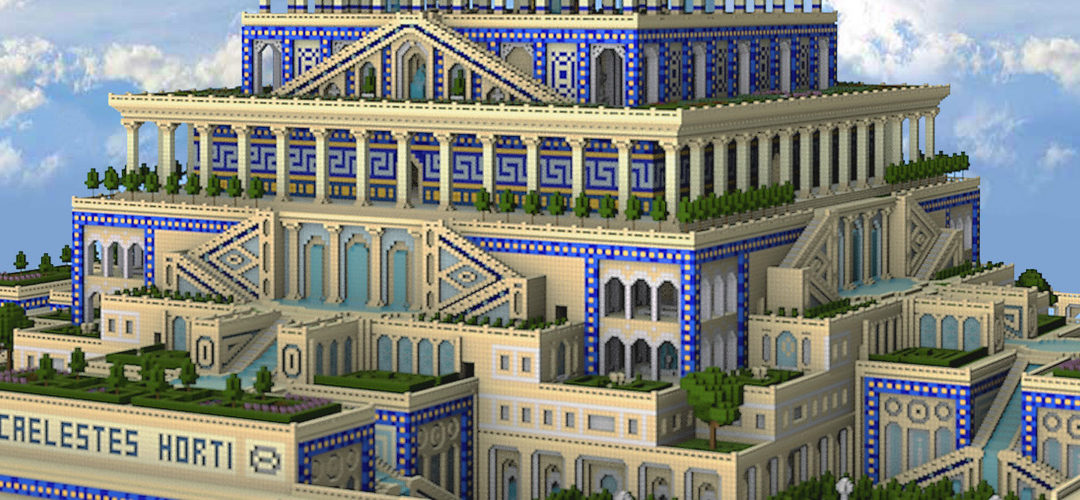
by Stone Marshall | Dec 12, 2018 | Awesome Book News, Free, Intro, Minecraft News, Minecraft questions, news, parent-news, State of Stone, Stone Marshall Book News, Stone Marshall Books, Stone Marshall Club, Stone Marshall Minecraft Adventures, Uncategorized |
ArchiGa’s Sky Gardens put the ‘culture’ in ‘horticulture’!
We do love a good Greek temple here at Minecraft HQ, and today’s build, ArchiGa’s Sky Gardens, really ticks that box. It’s the crossover we never knew we wanted: somewhere between a wedding cake and the Hanging Gardens of Babylon!
Built for a Skyscraper Contest on Planet Minecraft, Sky Gardens is a towering giant of classical Greek architecture, with a detailed interior and probably at least 100 pillars on the inside and outside. That’s a lot of pillars!
The blue and yellow colouring of Sky Gardens is inspired by the real-life Hanging Gardens, which was one of the Seven Wonders of the Ancient World, along with other long-lost structures like the Lighthouse of Alexandria and the Colossus of Rhodes. Many people have tried to recreate the Gardens, in paintings, drawings, and poetry, imagining what it might have looked like when it still stood. It’s not even the first time the Gardens have appeared in Minecraft – it’s a popular project for people looking to show off their skills!
But ArchiGa’s Sky Gardens – also known as Caelestes Horti, or “Sky Gardens” in Latin – is not exactly the Hanging Gardens. Although it is inspired by the legendary building, it’s not an exact recreation, says ArchiGa, who describes it as an “idyllic place to be in contact with nature and art… a physical and mental escape from the daily world.”
Taking inspiration from the architecture of Naples, the west coast of Italy where Pompeii and Vesuvius can be found, ArchiGa decided to build something in a classical style. “I wanted to celebrate my territory,” says ArchiGa, who lives in the area. “It influenced not only my creativity and personality, but was also very important for the spread of Western culture.”
ArchiGa even visited the Neapolitan gardens, ranging from “monumental royal parks” to “small gardens with a breathtaking view of the sea”, learning about the colours, style, and symmetry of the buildings while he planned the Sky Gardens build.
By far the most challenging part of this colossal build wasn’t the height, or the symmetry, or even the gardens themselves – but the frescoes that can be found on the walls inside (a frescoe is a painting done rapidly in watercolour on wet plaster on a wall or ceiling).
“Frescoes were intended to ennoble the rooms where they are,” says ArchiGa. Each fresco was planned and built by hand. One is a mythological design, based on the work of Neapolitan Baroque painter Luca Giordano, and another is a map of the Gulf of Naples. It’s tricky to make detailed art with blocks, but ArchiGa definitely managed it!
The most impressive task that ArchiGa took on, though, is the attention he paid to the baffling rules of architectural mathematics. When making builds, he tries to stick to the principles of proportion, which ancient architects would use to build things according to specific ratios. He even wrote a blog about it! “I wanted to amaze people,” ArchiGa admits, “and I think I did it!” I think so, too!
What’s even more impressive is that ArchiGa didn’t even plan out the Sky Gardens before building it. “I directly built my idea in blocks, and there were a lot of attempts at colours, or shaping the elements and the structure itself.” He admits that this took a lot of time – at least three hours a day for 20-25 days. “Composing the frescoes and the gardens was slow and careful work,” he says, but it definitely paid off! The interior is just as impressive, if not more impressive, than the exterior, with fountains, pools, arches and ten statues representing the six architectural values as well as the four elements: water, fire, earth and air.
The only remaining question is: why don’t we have hanging gardens any more? Wouldn’t the world be a lot prettier if we knocked down a few buildings and replaced them with gigantic fountain-filled wonders? I know if I ever build a city, I’m hiring ArchiGa.
Renders by Palliotto, Tinctorium and Omegafoxx
REad more online: https://minecraft.net/en-us/article/reach-sky




